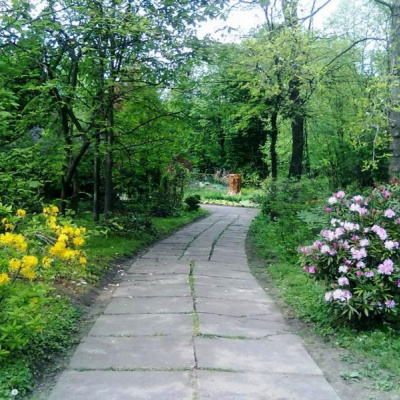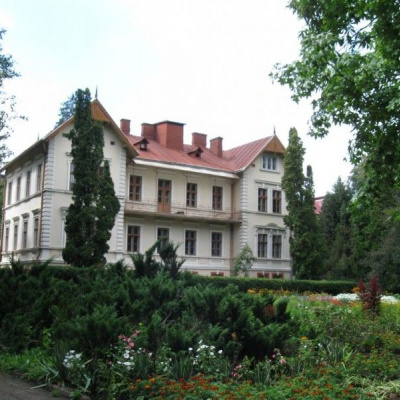"Arboretum and Botanical Garden of Chernivtsi National University" Chernivtsi
The Botanical Garden of Chernivtsi National University is a protected area of national importance in Ukraine. The area is 3.5 hectares. The Botanical Garden is one of the scientific departments of Yuriy Fedkovych Chernivtsi National University. You don't have to go to Africa to visit the tropics - the garden's greenhouse offers about 920 varieties of tropical plants. The Botanical Garden in Chernivtsi is one of the oldest in Ukraine, which is why it is a protected area. The garden was founded during the Austro-Hungarian Empire, back in 1877. Saplings were imported from Austria.
In 1880-1890, the botanical garden was formed as a scientific center. The well-known botanist Karol Bauer worked on the creation and development of the garden's territory until 1894. During this time, he laid the foundation of the site, determined the architectural layout and direction of work.
The botanical garden was created over 11 years. There is even a white poplar tree preserved here, planted by the first director of the botanical garden, Austrian professor Eduard Tangle. Later, the institution began to plant plants typical of the Chernivtsi region. Today, the majestic park has several departments: park science, dendrology, tropical and subtropical plants, and herbaceous plants.
The greenhouse is home to many varieties of floral and tropical plants - about 920 species:
- tulips are widespread, with more than 100 species;
- daffodils are represented by 70 species;
- magnolias - 18 species;
- 145 species of cacti;
- 70 species of irises;
- 60 species of chrysanthemums and many others.
The botanical garden is especially picturesque in spring, when plants wake up from their winter sleep and bloom, showing their beauty to the world. White and pink blooms of magnolia, bright colors of tulips, and the scent of lilies of the valley - all of this fascinates and inspires.
Basic facts about the botanical garden
- The question of creating a botanical garden as a base for the development of biological research arose immediately after the opening of the university in Bukovyna in 1875. At that time, the romantic style was becoming increasingly important in garden and park construction.
- The honor of creating the Botanical Garden project was given to Karl Bauer, the royal botanical gardener of Lviv University. It was decided to give the Garden a landscape character, to divide it into several lawn parterres, to plant groups of herbaceous plants on the periphery, and to group trees and shrubs in the center by genus complexes, with separate areas for perennials and annuals. On June 9, 1876, the Garden's project was submitted for consideration. It was checked and approved by the chairman of the board of the Franz Josef University in Chernivtsi, Professor Dr. Eduard Tangl, and the proposed project was reviewed and approved at a meeting of the Academic Senate.
- On July 13, 1876, at a meeting of the city's community council chaired by Mayor Ambrose, a decision was made to allocate a free plot of land for the Botanical Garden to the university.
- In September 1877, on the opening day of the Botanical Garden, the then head of the state government Julius von Wazl planted the first tree - silver poplar. The establishment of the arboretum under the leadership of Karl Bauer lasted for another 11 years. Exotic trees were imported from European nurseries, in particular from Muskauer's, and seedlings of local species were donated by the directorate of the Orthodox Religious Foundation of Bukovyna. For 60 years, the Botanical Garden of the Imperial Royal University in Chernivtsi was the only botanical garden in the Carpathian region and became a vivid embodiment of the architectural trends of that period.
- The first director of the Botanical Garden was Professor Eduard Tangle (1877-1905), who later headed the Institute of Botany, which was located on the territory of the Garden. Under his leadership, collection and auxiliary greenhouses, an administrative building with an apartment for the Garden inspector, a lecture hall and a classroom, a room for an assistant, a house for the guard, and outbuildings were built.
- In 1878, at the request of Professor E. Tangl, a herbarium was purchased for the Garden, in 1979 equipment was purchased, and in the spring of 1890 the exchange of plants and seeds with foreign botanical gardens began. This Austrian scientist made a significant contribution to the development of botanical science in Bukovyna, having trained a whole galaxy of outstanding local researchers. During the Austrian period, scientific work was based on the study of the Carpathian flora and the creation of collections of native plant species that were placed on the parterre lawns, the Carpathian hill, rock garden, and in the pool.
- In 1906, Friedrich Čapek, an ordinary professor of the German Technical Higher School in Prague, a plant physiologist, became the director of the Garden and the Institute of Botany. In 1914, the collections of the Botanical Garden of Chernivtsi University included 1500 plant species, the vast majority of which were local species.
- In 1918, Bukovyna became part of the Romanian Empire and the Garden was subordinated to the Institute of Botany. It was headed by a Bukovynian Mykhailo Hushuliak (1887-1960), a 1911 graduate of Chernivtsi University and future corresponding member of the Romanian Academy of Sciences. His research opened up environmental issues in Bukovyna. During this period, the work on studying and systematizing the flora of the region, creating a herbarium and collections of native species intensified. The quality of the collections of those times is evidenced by the handwritten inventory lists that have survived to this day, and the areas of research are evidenced by the Seed Catalogs offered by the Garden for exchange, which contain specimens collected in nature with an indication of localities.
- Botanical research was carried out by professors of the Institute F. Prokopiyan-Prokopovych (a stele with his name still adorns one of the cozy corners of the Garden), M. Hushuliak, R. Prokopovych, and the Garden's inspector K. Bauer. S. Sirchynskyi, Fr. Ustianovych, P. Prescurea, K. Köchler, E. Hnida, and the Garden's assistants in different years were A. Mildorf, M. Drachynskyi, and since 1926 E. Tsopa. The main attention was paid to the classification of flora, systematics and phylogeny of individual genera.
- With the annexation of Bukovyna to Ukraine in 1940, the garden was transferred to Chernivtsi State University. The main focus of its activities was the introduction and acclimatization of plants. The first printed lists of seeds are published. From 1944 it was headed by Professor H.H. Molotkovsky, from 1950 - by Associate Professor M.V. Orekhov, and later - by Professor I.V. Artemchuk, Associate Professors Z.K. Kostevych, V.V. Danyshchuk, M.G. Murzenko, from 1972 to 1985 - Doctor of Biological Sciences, D., prof. B. Termena, from 1986 to 1996 - PhD, senior researcher V. Havryliuk, from 1996 to 2003 - senior researcher L. Halytska, from 2003 to 2011 - senior researcher M. Vykiuk, from 2011 to 2014 - M.S. I. Morozova, from 2014 - PhD, senior researcher T. Derevenko. Under their leadership, the greenhouses and expositions were rebuilt, relations with more than 180 countries were established, the first printed lists of seeds were published, an exposition greenhouse was built, and paved paths were laid. Work began on the introduction and acclimatization of plants, the study of natural resources and the cultivation of species of the natural flora of the Carpathians and Prykarpattia: natural fodder lands were studied, geobotanical studies of meadow and forest phytocoenoses, and the seed productivity of herbaceous plants were conducted. Under the leadership of the Director of the Garden (1971-1985), from 1985 to 2010, Professor of the Department of Botany B.K. Termena, the study of the biology of development and adaptive abilities of woody introductions depending on geographical origin was initiated, a method of mathematical modeling of adaptive abilities of woody plants was developed, with the help of which mathematical models were built to predict the success of the introduction of woody introductions; a survey of the dendroflora of ancient parks was started.
- In terms of area (3.5 hectares), it is the smallest Garden in Ukraine. In 1956, the arboretum of the former Residence of the Metropolitans of Bukovyna and Dalmatia (Chernivtsi Arboretum of National Importance) was added to the Garden, the basis of which is planted with native species on an area of 4.8 hectares. In 1969, the Botanical Garden received the status of a scientific institution. In 1983, it was included in the Nature Reserve Fund of Ukraine, and in 1992 it was granted the status of a protected object of national importance.
- Today, the Botanical Garden of National Importance is one of the scientific departments of Yuriy Fedkovych Chernivtsi National University. Until 2003, there were two departments: introduction and flora; after 2003, four departments were created: dendrology, herbaceous plants, tropical and subtropical plants, and park science. The Garden also has a seed laboratory, a scientific library and a herbarium. Scientific research and maintenance of collections are carried out by 12 researchers (including 3 candidates of biological sciences), who are now leading specialists, as well as 16 specialists and laboratory assistants.
- The collection funds are the basis for the educational process and scientific research, the results of which are summarized in 8 PhD and 1 doctoral dissertations in plant physiology, as well as in 19 PhD and 1 doctoral dissertations in botany.
- The Botanical Garden of Chernivtsi National University is a real museum of living plants from different ecological and geographical zones of the world. Its collections are of great scientific, educational and environmental importance.
- The Botanical Garden of Chernivtsi National University is located at 11 Fedkovycha Street. The director is Tetiana Derevenko, PhD in Biology, SSS. Nearby there is a taxi stop #5 - "Suvorova Street", from where you need to walk a block to the botanical garden. There is also a bus stop on Sadova Street, where minibuses #3, #4, #6, #9A, #10, #10A, and #27 run.
- Chernivtsi is the capital of Bukovyna. It is one of the most beautiful and pleasant Ukrainian cities. There is one of the most beautiful railway stations in the country, the Church of St. Paraskeva of Serbia, the Church of the Exaltation of the Cross, the ship house, the City Hall (every day at 12:00 a trumpeter plays the melody of "Marichka" from the tower), the Art Museum, then Kobylianska Street, the German Folk House, the Armenian Church and the Assumption Church (the oldest stone Ukrainian Greek Catholic Church in Chernivtsi), the Theater Square and the Kobylianska Theater. Kobylianska Theater Square, Jewish People's House, Chernivtsi University (included in the UNESCO World Heritage List), Turkish Square (Chernivtsi has been a part of Turkey, Modova, Romania, Austria-Hungary, the USSR, Rus, and Ukraine), and a large rover, cozy streets and cobblestone streets, the so-called Drunken Church, Nazariy Yaremchuk's house, then another house-ship, two houses with the same number (Olha Kobylianska lived here), the house where Volodymyr Ivasyuk lived, the pink church - the Cathedral of the Holy Spirit.
Chernivtsi sights
- St. Nicholas wooden church (from 1607, restored in 1954);
- stone Church of St. George on the Bitterroot (1767 in the Baroque style);
- wooden Trinity Church in Muggles (one thousand seven hundred and seventy-four), moved in 1874 to Kłokuchka;
- wooden Assumption Church on Kaleczanka (1783);
- City Hall with a two-story, 45-meter-high Empire-style tower (1843-1847, architect A. Mykulych), now the City Council;
- Ukrainian Greek Catholic Church (1825-1830 in the Baroque style);
- Byzantine-style cathedral (1844-1864, architect Roll);
- Church of St. Paraskeva in the pseudo-Romanesque style, completed in 1662 (architect A. Pavlovsky);
- residence of Bukovyna metropolitans - since 1956 one of the buildings of Chernivtsi University);
- Armenian Gregorian Church (1869-1875, architect J. Hlavka);
- Chernivtsi University building (1874-1875);
- Jesuit church in the Neo-Gothic style (1893-1894);
- Railway station (1898-1903) in the Art Nouveau style;
- the City Theater (1904-1905, architects F. Fellner and G. Helmer) in the Viennese Baroque style with Art Nouveau elements (now the O. Kobylianska Music and Drama Theater), etc.








